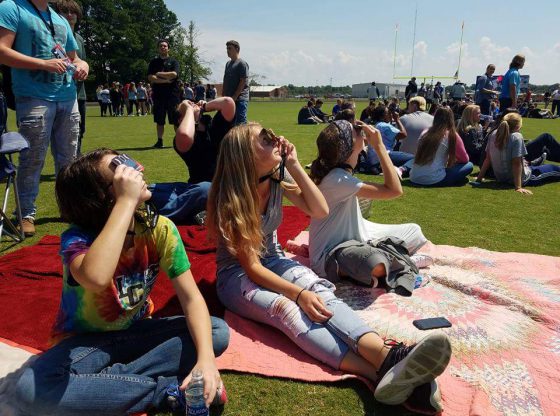August 21st, 2017 became a memorable day for the state of Kentucky and the United States as a whole, as some parts of the state were able to witness the first total solar eclipse since February of 1979. Some students at LCHS decided to take an “educational day” to view the eclipse from the safety of their homes, while others decided to brave the heat and watched it from the football field at school. Some were even willing to put up with traffic to travel to Hopkinsville to get a 100% totality view of the eclipse. The perspectives varied throughout these different areas of Kentucky, and the experiences gained had some similarities and some major differences.
Monday, Rachel Sheffer was one of the many students who left class towards the end of the day to watch the view from the football field with “viewers” that were donated by WKU. Rachel said she was “excited and surprised” about the eclipse and the fact that we would be able to view it “without even having to leave [our] home.” However, when asked if the solar eclipse lived up to her expectations, she responded with “Unfortunately, it did not meet up to my expectations.” Since the school only had 98% totality, she explained that “it did not get as dark as I initially thought, and we were not able to look up at the eclipse without our glasses.” Even though she wasn’t able to experience the eclipse in 100% totality, she doesn’t regret her decision to see it at school. “Now I know what it is like seeing it in 98% totality!”
Rather than going to Hopkinsville or school, Dakota Martin decided to watch the eclipse from the safety of his home. Going along with what Rachel said, Dakota also agrees that “the reality did not match up” to his initial expectations because he wasn’t in the line of totality for the eclipse. Opposed to Rachel, however, he does regret not going to Franklin county or Hopkinsville “because [he] didn’t get to see the corona around the moon.” But by the year 2024 when the next total eclipse is expected to occur in the United States, he stated “I have plans with a friend already to view the complete eclipse.”
Aside from going to school or staying home, the only other option was to travel towards Hopkinsville to experience the 100% totality of the eclipse. Mary Gearon decided to take an educational day from school on Monday to watch the eclipse from Franklin County. Upon hearing about the eclipse, Mary stated, “I knew I had to go.” When I asked about how to reality matched up to her expectations, she said, “It exceed my expectations. It was amazing and totally beautiful, I was shaking when I saw it.” In comparison to the others who stayed at home or school, Mary says it was completely worth it to go to Franklin County to view the 100% eclipse. She plans to try to see it in the year 2024 with the people she holds most dearly.
Through these 3 point of view alone, it’s very clear that the perception of the eclipse varied greatly based on where you were. Some had a breathtaking view of the eclipse while others were very disappointed with the 98% totality. Either way, all 3 students plan to see the full 100% totality of the solar eclipse in the year 2024.

